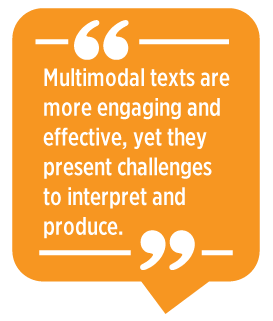Embracing Multimodal Writing Tasks in ESOL Classes
by Qiandi Liu and Cyndriel Meimban

The past decade witnessed a rapid transition from
print to digital communication. In print texts, meaning is conveyed through
linguistic and visual means. In digital texts, meaning-making takes advantage
of a hybridization of two or more of the five modes of representation:
linguistic, visual, audio, gestural, and spatial (The New London Group, 1996).
Multimodal texts are more engaging and effective, yet they present challenges
to interpret and produce. With multimodal digital communication gaining increasing
popularity, teachers are faced with the task of helping students develop
multiliteracy for academic, professional, and social writing purposes.
Nonetheless,
due to different educational backgrounds and familiarities with new
communication technologies, not all teachers feel confident and comfortable in
implementing multimodal writing tasks in their classes. Our goal in this
article is to help teachers gain a deeper understanding of the nature,
benefits, required skills, and challenges in incorporating pedagogical
multimodal writing tasks in English language classrooms. We also demonstrate,
through three examples, how to transform traditional text-based writing prompts
into multimodal writing tasks.
Defining Pedagogical
Multimodal Writing Tasks
Pedagogical
multimodal writing is commonly defined as tasks requiring learners to create
multimedia digital products that integrate a variety of semiotic resources
(Balaman, 2018). We argue that this definition is limited because it focuses
exclusively on the productive end and overlooks the receptive dimension of such
tasks. When students are asked to produce multimodal texts, they are typically
provided with multimodal prompts. Interpreting and synthesizing materials from
multiple modes and sources constitutes a crucial step toward the completion of
a multimodal writing assignment. We, therefore, propose an expanded definition
that includes both the receptive (input) and productive (output) ends of
pedagogical multimodal writing tasks.
Multimodal
writing prompts can be a combination of
-
linguistic (written texts),
-
audio (e.g., songs,
podcasts, audiobooks),
-
visual (e.g., photographs,
comics, diagrams, figures), or
-
audiovisual (e.g., videos,
videorecorded lectures, movies) input.
Multimodal
output can take a variety of forms. It can be
-
visual (e.g., posters,
brochures, storyboards, infographics, blogs, newsletters, graphic novels),
-
audio (e.g., voice
recordings, podcasts, oral presentations), or
-
audiovisual (e.g.,
animation, book trailers, music videos, interactive stories, vlogs, and short
films).
Benefits of Multimodal
Writing Tasks
 Compared
with traditional writing assignments, multimodal writing tasks have several
advantages. First, they are more authentic because they reflect the recent
shift toward digital, multimodal communication in the world. Second, they
accommodate the needs of different learner types (e.g., visual, aural, verbal,
and kinesthetic). Third, they encourage deeper task engagement as learners must
interact closely with multimodal information to gain a thorough understanding
of an issue before they can discover new ideas or propose innovative solutions
(Sadik, 2008). Finally, digital multimodal texts can be easily shared, reviewed
by teachers and peers, and published online to reach a larger audience, which
motivates learners to produce higher quality work (Yoon, 2012). Second language
learners also develop linguistic competence (Balaman, 2018) and critical
problem-solving skills (Yang & Wu, 2012) in the process.
Compared
with traditional writing assignments, multimodal writing tasks have several
advantages. First, they are more authentic because they reflect the recent
shift toward digital, multimodal communication in the world. Second, they
accommodate the needs of different learner types (e.g., visual, aural, verbal,
and kinesthetic). Third, they encourage deeper task engagement as learners must
interact closely with multimodal information to gain a thorough understanding
of an issue before they can discover new ideas or propose innovative solutions
(Sadik, 2008). Finally, digital multimodal texts can be easily shared, reviewed
by teachers and peers, and published online to reach a larger audience, which
motivates learners to produce higher quality work (Yoon, 2012). Second language
learners also develop linguistic competence (Balaman, 2018) and critical
problem-solving skills (Yang & Wu, 2012) in the process.
Knowledge and Skills
Required for Multimodal Writing Tasks
The design
and development of multimodal texts are complex and demand an orchestration of
multimodal literacy knowledge and skills, including the following:
-
Rhetorical
competence: Students should have rhetorical competence in
analyzing a writing prompt so they can identify the intended audience and the
purpose of writing.
-
Multiliteracy
skills: Students should understand how meaning is constructed
through individual communication modes and how the hybridization of multiple
modes synergistically conveys the intended information (Jewitt, 2009). Lacking such
knowledge can lead to a superficial mixture of multiple modes that is
detrimental rather than facilitative in reaching communicative goals.
-
Technical
skills: Students should know how to use word processing software
(e.g., Microsoft Word, PowerPoint, and Publisher) to create printable posters,
brochures, and newsletters. They should also be skillful in using online
writing platforms (e.g., Google Docs, Edublogs, Wix, WordPress, and Google
Sites) to create digital texts. Moreover, they should be able to create images
and record audio and videos using smartphones or professional devices and
software (e.g., Photobooth, Voice Recorder Pro). Additionally, basic skills in
editing and formatting multimodal files are necessary for enhancing the overall
effectiveness of communication.
Challenges
in Multimodal Writing Tasks
Although the
younger generations are known for being tech-savvy, they use electronic devices
mainly for social purposes, including texting, social media, gaming, dating,
and news (Kalogeropoulos, 2019). They generally lack the digital literacy
skills required for academic tasks. Moreover, even though students are exposed
to multimodal texts daily, they may not have acquired the essential knowledge
and skills in creating them. It is teachers’ responsibility to help them
develop such competence to successfully interpret and construct multimodal
meaning. Through situated practice, students become “active designers” of
social futures (The New London Group, 1996, p. 64).

Teachers
play a vital role in multimodal writing projects. They must be familiar with
how different communication modes create meaning, separately and in tandem with
each other. In addition, they should be able to help students make informed
decisions on choosing the most effective combination of modes in a specific
communicative context. This necessitates proper training to help teachers gain
expertise in these areas before they can impart such knowledge and skills to
students.
In the
following section, we demonstrate, through three examples, how teachers can
easily transform traditional writing prompts into multimodal tasks.
Three Multimodal ESOL
Writing Tasks
1. Silent
Film
In this
task, a short silent film (e.g., Disney Pixar’s Mouse
for Sale) is used as the visual writing prompt. The video
challenges students to utilize their imaginations and stretch their vocabulary
reservoirs to write a story. Teachers may choose to highlight a specific
grammar point (e.g., “write using simple present tense”) or writing skill
(e.g., “use sensory descriptions”).
This prompt
can be used for both young and adult English language learners. Young learners
can be asked to script the film followed by a postwriting acting-it-out task.
Adults can be required to complete a hybrid narrative-descriptive-summary
writing that combines narrating the story with personal reflections on its
meaning. Because the stimulus itself is wordless, the plot and characterization
are open to numerous interpretations. There is no right or wrong answer as long
as the student writer can use visual evidence from the film to support their
writing. It is fascinating to see what themes different students take away from
the silent film and explore in their writing.
2.
Beyond-the-Essay Task
Traditional
writing tasks offer a limited platform that fails to show students the impacts
of writing beyond the immediate context of classrooms. Pedagogical writing
tasks must not take place in a vacuum; instead, they should reflect
multifaceted reality and make substantive connections to the larger stage in
the real world. This Beyond-the-Essay task offers such an opportunity.
In this task,
students are asked to produce a podcast or YouTube video that accompanies an
essay assignment. In addition to submitting an argumentative essay in support
of abolishing grades at school, students can be asked to create a YouTube video
showing them interviewing students and teachers who agree and disagree with the
essay’s argument.
The
audiovisual production serves as the reinforcement of a student’s ideas in an
essay and a synthesis of other perspectives. It can be easily uploaded on a
student’s or the whole class’s YouTube channel to share with a larger audience.
The fact that their videos can be viewed by anyone on the internet and
commented on by critics and supporters alike is likely to incentivize students
to be more engaged in the task and produce higher quality work.
3.
Revising-Reflecting-Recording (3Rs)
Traditional
process-oriented writing requires students to reflect on their writing, revise
for content, and edit for accuracy. Occasionally, students are asked to write a
companion piece to explain how they get from Point A (prewriting) to Z
(printing/publishing). This metawriting activity comes in several forms (Ferris
& Hedgcock, 2014), two of which are as follows:
-
Explanative Letter:
A short reflective memo or cover letter is attached to the final draft,
explaining how the student writer chose to apply (or not) instructor and/or
peer feedback.
-
Editing
Log: This log serves as an inventory of errors and corresponding
corrections, further helping students notice patterns and avoid fossilization.
These tasks require
students to write again about writing. With the writings alone, teachers can
rarely tap into the thinking processes which prompt students to make certain
decisions in revising.
An
alternative is a 3Rs task, which requires students to record an audio
reflection after completing a multidraft essay assignment. The recording serves
the dual purpose of a “palate cleanser” (activating a different language
domain—speaking) and a new angle to illuminate the nuances of individual
writing processes. A single audio recording can be 1–2 minutes long. Students
can be given a brainstorming worksheet to frame and deepen their reflection.
The recordings can be used by instructors to analyze students’ revising
processes, decisions, and strategies to give them better revision advice and
guidance.
These tasks
can be adapted for different learner groups or instructional contexts. We hope
that this paper inspires English language teachers to transform conventional
writing assignments into multimodal projects to better help students develop
multimodal literacy skills.
References
Balaman, S.
(2018). Digital storytelling: A multimodal narrative writing genre. Journal of Language and Linguistics Studies,14(3), 202–212.
Ferris, D.
R., & Hedgcock, J. S. (2014). Teaching ESL composition.
Purpose, process, and practice. Routledge.
Jewitt, C.
(Ed.). (2009). The Routledge handbook of multimodal
analysis. Routledge.
Kalogeropoulos, A. (2019). How younger generations consume news differently and the implications
for mainstream media. Flamingo. https://reutersinstitute.politics.ox.ac.uk/sites/default/files/2021-02/FlamingoxREUTERS-Report-Full-KG-V28.pdf
The New
London Group. (1996). A pedagogy of multiliteracies: Designing social features.Harvard Educational Review, 66(1),
60–93.
Sadik, A.
(2008). Digital storytelling: A meaningful technology-integrated approach for
engaged student learning. Educational Technology Research and
Development, 56(4), 487–506.
Yang, Y. T.
C., & Wu, W. C. I. (2012). Digital storytelling for enhancing student
academic achievement, critical thinking, and learning motivation: A year-long
experimental study. Computers & Education, 59, 339–352.
Yoon, T. (2012). Are you digitized?
Ways to provide motivation for ELLs using digital storytelling.International Journal of Research Studies in Educational
Technology, 2, 25–34.
Qiandi
Liu is currently an assistant professor of
the Linguistics Program and the Department of English Language and Literature
at the University of South Carolina. Her research expertise lies in second
language writing, written corrective feedback in particular. Her teaching has
focused on MA-TESOL certification courses and pedagogical grammar for
secondary English language arts teachers.
Cyndriel
Meimban is currently an academic specialist
in the Academic Support Unit of the nonprofit organization Harlem Children’s
Zone. Her work in the past 10 years has been centered on classroom instruction
(in-person and online), curriculum design, and teacher training in the contexts
of ESL/EFL in higher education and ELA in K–12.